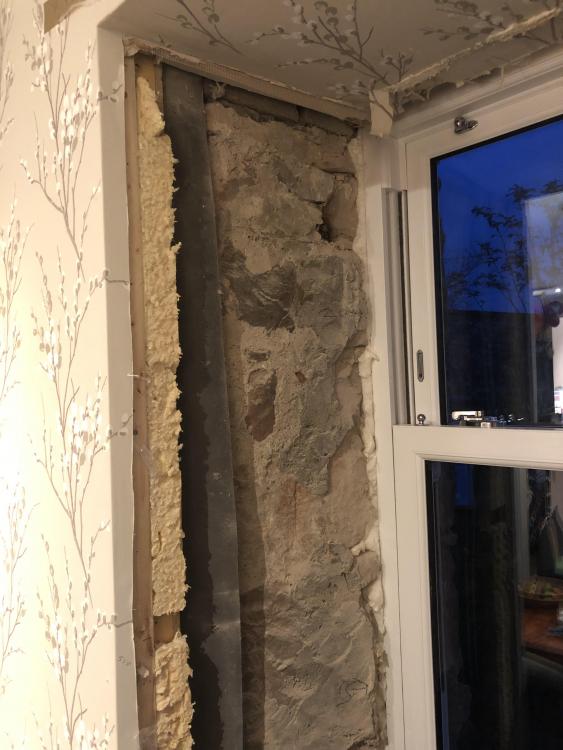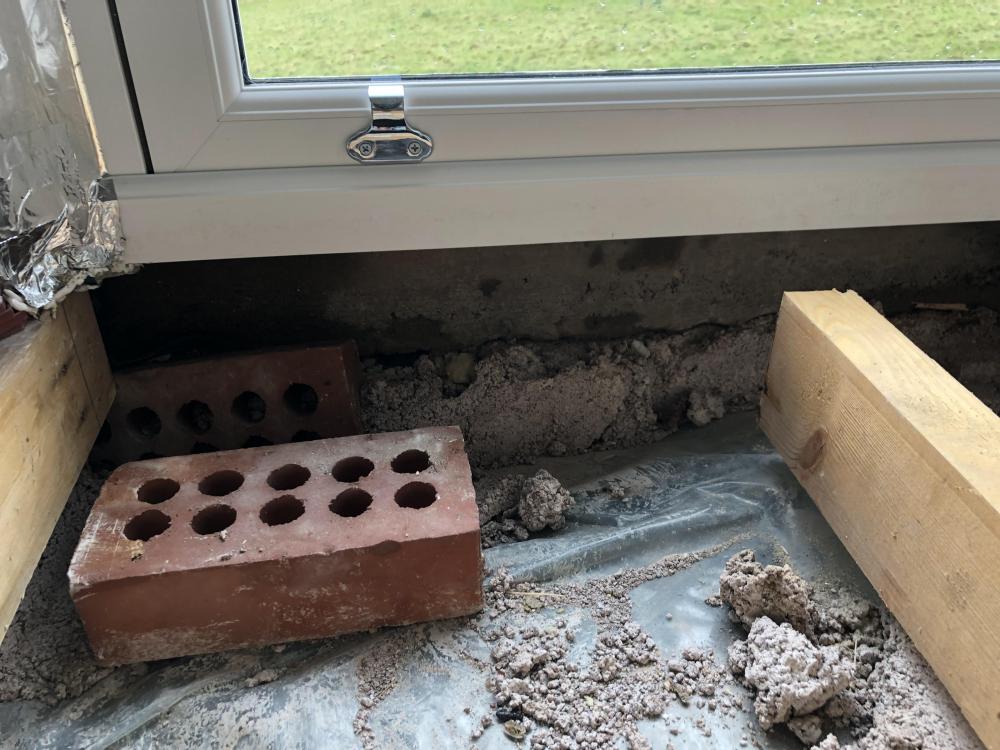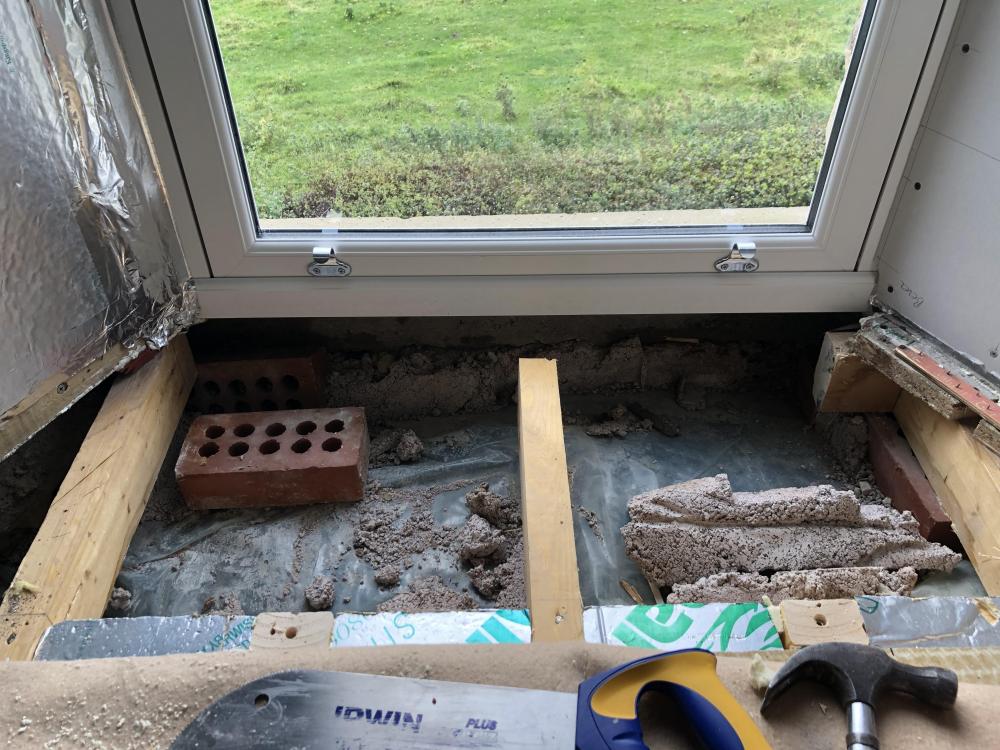
Kilt
Members-
Posts
117 -
Joined
-
Last visited
Recent Profile Visitors
The recent visitors block is disabled and is not being shown to other users.
Kilt's Achievements

Regular Member (4/5)
7
Reputation
-
cheers for replies.
-
In Scotland, what would be the recommend, most robust finish for transition from cope stones to slate? Seems similar arguments for a skew fillet over soakers or a Watergate, with cover flashing under the copes, leading over the soakers. I have the option for either, we current have soakers and fillet and live in a VERY exposed location. A fillet seems more robust to the wind, than flashing. Am I right in thinking when applying fillets, they should not be in-contact with the slate during curing and be separated by paper/felt/greaser. Metal lath can be added for extra strength??? Any advice would be appreciated.
-
Dot and dab foil backed 9mm PB was their answer. the worst offending area, I kicked off, as there isn’t sufficient margin for any build up. they’re coming back in spring to take window out and alter stone work for that one. .
-
A lot of the stone work is lime mortar, or soil based, so any disturbances, create massive movements. It’s all rubble/field stone, some are massive stones, so I could end up with some pretty big holes! ?
-
Looking for recommendations for insulation around window reveals. Just had new upvc sash windows put in our barn conversion, replacing rotten old ones, however the new frames are far thinner than old, (window company cockup) so im struggling with some of the reveals and getting some insulation in there. The tightest clearance is 20mm. Looking for advice. I had thought about using super quilt, but without the recommended battons, or using some insulated board of some form. I even tried Wedi board, but it’s too brittle to support a plaster finish and kids. attached photo is of one of the better reveals, I’ve been able to get battons and 20mm PIR in here.
-
Incase someone in the future searches for this, I spoke to Wedi. They say don’t use PVA, recommend SBR or a acrylic based primer. However in the same sentence they also say use whatever plaster manufacturer recommends.
-
Any recommendations for primer? Wedi say yes you can plaster onto it, but with a “suitable primer”. Anyone used one that’s worked? pva, sbr or febond blue grit?
-
Yeah that’s the major concern, even with the mvhr, there’s going to be a big difference in temp, with the kitchen next door, humidity is going to be higher
-
Short - Daft idea is to leave external rubble stone, window ingles open and on show. I’d re-point it up in lime and probably give it a few coats of a (hot) lime-wash. Long - I’ve just had 10 new windows put in, and there’s been a bit of a surprise behind one of the existing stud/PIR insulation walls. During the original conversion, they never removed enough stone on this one window opening. So the stud work was only about 20mm thick, as was the pir. The new window has thinner frames, so I’ve subsequently only 13mm to play with, between stone and window opening mechanism. Now I either take out stones/sthil saw offending stones, to give me some space, to rebuild… or a leave it open and on show. I haven’t been able to find any dot-dab insulated plasterboard, thin enough, and can go on an external wall. Issues - I have a timber kit home internally, and a cavity, so closing that off might be tricky. Window opening is close to a kitchen, so household humidity is at its highest, but we have a MVHR, so rest of house sits at around 50% humidity.
-
What to do with this mess of a concrete sill?
Kilt replied to Kilt's topic in General Self Build & DIY Discussion
-
I’ve just had a new window put in, and was checking underneath for a draft. Ive found the concrete-precast sill has no DPC or much of anything behind it. There was a load of bricks just chucked in the gap, prior to photos. The external building is a rubble-stone barn conversion, all done in lime. what should I do, back fill the sill with lime mortar, to try and minimise water ingress? no way of getting a DPC in.
-
I talked to Masons Mortar and they said no, can't be used with UPVC. I have been trying to avoid using cement on the property (18th Century, lime etc) but at this time of year, don't really know what the options are to fill the 2-30/40mm gaps.
-
Masons-mortar use 'Rosin oil' in their burnt sand. Sadly no data sheet, so will give them a call later today. Not come across 'Rosin' before, but a terrible google search pulls up not to use on plastic due to leaching (which I guess it damaging plastic), but that's if you're planning on eating the Rosin!
-
I’m assuming it’s the oil, if some of the ready-mix stuff use petroleum oil, rather than a natural base like linseed. Purely speculating. The only thing I’ve found is on a Everbuild Site for their trowel mastic, which states: ”LIMITATIONS ▪ Unsuitable for plastic frames heat absorbing glass.” but that’s petroleum based.
-
I’ve been led to believe that burnt sand mastic is detrimental to upvc, and shouldn’t be used. however I’m struggling to find any factual basis to back this up. does anyone know if this is true? I’m trying to marry up old wonky stone work and seal some newly installed windows.





